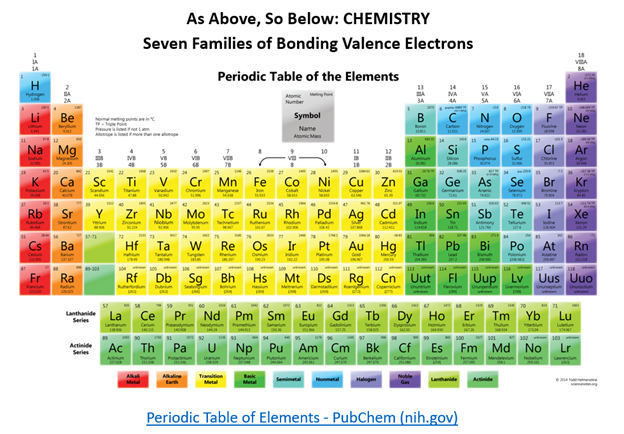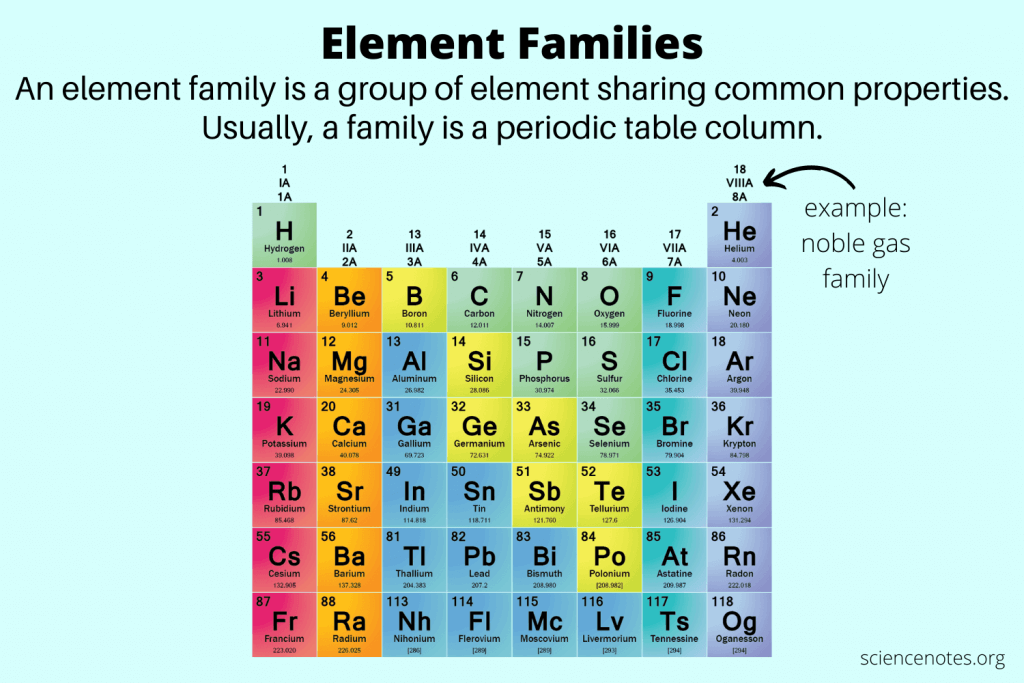Chapter 9 Periodic Table
The concept of relating the Bailey Rays to the families of elements in the periodic table is an intriguing exercise in cross-disciplinary synthesis.
Drawing parallels between Alice Bailey’s seven rays and the seven families of the periodic table is a creative, philosophical exercise. While it’s not grounded in empirical evidence or scientific reasoning, we can make educated suggestions based on the traditional qualities and associations attributed to each family of elements and each ray:

- Ray 1 (Will or Power) and Alkali Metals: Alkali metals, like lithium or sodium, are highly reactive, mirroring the assertive, driving energy of Ray 1.
- Ray 2 (Love-Wisdom) and Alkaline Earth Metals: Alkaline earth metals, such as magnesium or calcium, are essential for life, reflecting the nurturing, unifying nature of Ray 2.
- Ray 3 (Active Intelligence) and Transition Metals: Transition metals, like iron or copper, are versatile and used in diverse applications, paralleling the adaptability and practical intelligence of Ray 3.
- Ray 4 (Harmony through Conflict) and Post-transition Metals: Post-transition metals, including aluminum or tin, are often used to alloy with other metals, creating harmony and balance through their interaction, much like Ray 4.
- Ray 5 (Concrete Knowledge or Science) and Metalloids: Metalloids, such as silicon or arsenic, bridge the gap between metals and non-metals, symbolizing the concrete knowledge and understanding embodied by Ray 5.
- Ray 6 (Devotion or Idealism) and Nonmetals: Nonmetals, like carbon or oxygen, are fundamental to life and energy production, echoing the devotion and idealism of Ray 6.
- Ray 7 (Ceremonial Order or Magic) and Halogens: Halogens, like fluorine or chlorine, are highly reactive and often bond with other elements to create order and stability, fitting well with the ceremonial order and structure of Ray 7.
These associations are symbolic and subjective, varying across different cultures and belief systems. They serve as a philosophical exploration, a means of connecting the tangible physical world of elements with the abstract spiritual concepts embodied by Bailey’s seven rays. As with all philosophical explorations, it’s important to approach them with an open mind, while maintaining a clear distinction between metaphorical symbolism and empirical science.
Chemical bondings
The Bailey rays, as proposed by Alice Bailey in her esoteric philosophy, are metaphysical concepts that represent seven types of cosmic energy, with the first three rays being Will or Power, Love-Wisdom, and Active Intelligence or Physical Manifestation. Though these are philosophical concepts, we might draw some abstract parallels between them and the three primary types of chemical bonding – ionic, covalent, and metallic – in an attempt to bridge the gap between physical science and metaphysics.
- Will or Power (First Ray) and Ionic Bonding: The First Ray is associated with the idea of will or power, the driving force behind action and change. Similarly, ionic bonding represents a powerful force in the material world. When an atom donates or accepts electrons, it exerts its ‘will’ over another atom, creating charged ions that attract one another to form an ionic bond. This process leads to transformative changes in the identities of the atoms involved.
- Love-Wisdom (Second Ray) and Covalent Bonding: The Second Ray represents love-wisdom, which implies unity, connection, and mutual understanding. In a similar vein, covalent bonding involves the sharing of electrons between two atoms, symbolizing a deep connection and cooperation for mutual benefit. Like the wisdom that grows from love and connection, the shared electrons help both atoms achieve a more stable, ‘wiser’ state.
- Active Intelligence or Physical Manifestation (Third Ray) and Metallic Bonding: The Third Ray stands for active intelligence or physical manifestation, symbolizing creation, materialization, and practical intelligence. Metallic bonding, which happens among metal atoms, involves a ‘sea’ of delocalized electrons that allows metals to exhibit their unique properties like malleability, ductility, and conductivity. This can be likened to the practical, tangible manifestations of the Third Ray’s active intelligence in the physical world.
This comparison provides an interesting perspective, albeit conceptual, connecting the realms of physical chemistry and esoteric philosophy. It invites us to see scientific concepts not merely as isolated facts but as integral parts of a grand, interconnected tapestry of knowledge and understanding.